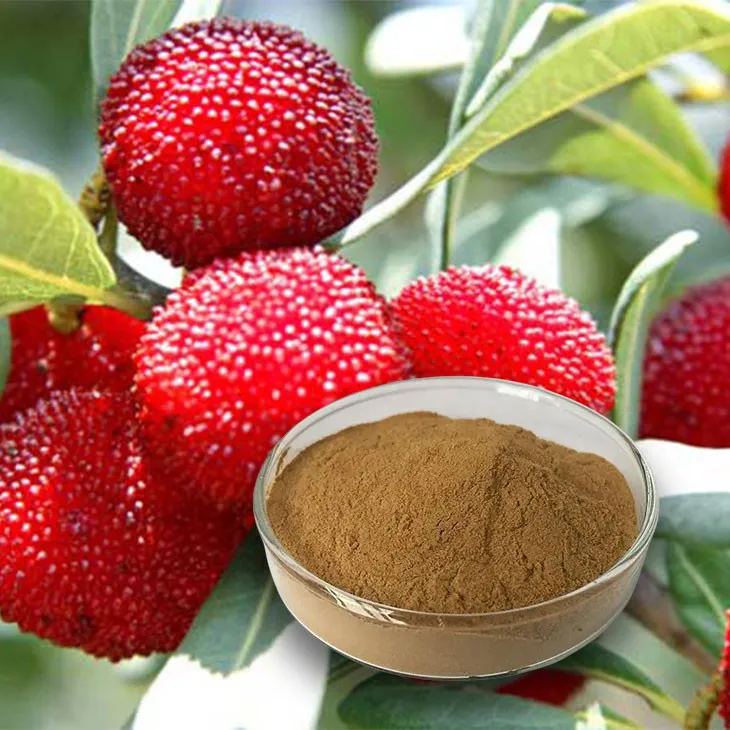- 0086-571-85302990
- sales@greenskybio.com
How to make powder with bayberry extract?
2024-11-30

1. Introduction
Bayberry is a fruit rich in various nutrients and bioactive compounds. Extracting these valuable components and converting them into powder form can have a wide range of applications, such as in the food, pharmaceutical, and cosmetic industries. This article will detail the process from the initial extraction of bayberry components to the final powder formation, while also considering factors like equipment, safety, and quality control.

2. Bayberry Extraction
2.1 Selection of raw materials
Quality bayberries are the foundation of a good extract. Select fresh, ripe bayberries without signs of decay or damage. The origin of the bayberries can also affect the quality of the extract. Bayberries from regions with suitable soil and climate conditions tend to have better flavor and higher nutrient content.
2.2 Cleaning
Thoroughly clean the selected bayberries. This step is crucial to remove dirt, pesticides residues, and other impurities. Wash the bayberries gently under running water, and then soak them in a mild saline solution for about 10 - 15 minutes. After that, rinse them again with clean water.
2.3 Extraction methods
There are several methods for extracting bayberry components:
-
Solvent extraction: Commonly used solvents include ethanol and water. Ethanol - water mixtures are often preferred as they can extract a wide range of compounds. Crush the cleaned bayberries into a pulp, and then add the solvent in a certain ratio (e.g., 1:2 - 1:5 of bayberry pulp to solvent). Stir the mixture continuously at a moderate speed for a certain period, usually 2 - 4 hours at room temperature or with gentle heating (below 50°C). Then, filter the mixture using a filter paper or a filtration device to obtain the extract solution.
-
Press extraction: This method is more suitable for obtaining larger - scale and relatively crude extracts. Use a fruit press to squeeze the juice from the bayberries. However, this method may not extract all the fine components compared to solvent extraction.

3. Concentration of the extract
3.1 Rotary evaporation
If solvent extraction is used, the obtained extract solution usually contains a large amount of solvent, which needs to be removed to concentrate the active components. Rotary evaporation is a common method. Transfer the extract solution to a rotary evaporator flask. Set the appropriate temperature (usually 40 - 50°C) and rotation speed according to the solvent used. The solvent will be evaporated under reduced pressure, and the extract will be concentrated gradually.
3.2 Vacuum concentration
Another option is vacuum concentration. Place the extract solution in a vacuum concentrator. Under vacuum conditions, the solvent will boil at a lower temperature, which helps to preserve the activity of the components. This method is especially suitable for heat - sensitive components in the Bayberry Extract.

4. Drying to form powder
4.1 Spray drying
Spray drying is a widely used method for converting liquid extracts into powder. Prepare the concentrated Bayberry Extract by adjusting its viscosity and solid content if necessary. Pump the extract into a spray dryer. Set the inlet temperature (usually 180 - 220°C) and outlet temperature (usually 80 - 100°C) according to the properties of the extract. The liquid extract will be sprayed into fine droplets through a nozzle, and the hot air in the dryer will quickly evaporate the water, leaving behind the powder form of the bayberry extract.
4.2 Freeze drying
Freeze drying is another effective method, especially for preserving the bioactivity of the bayberry extract. First, freeze the concentrated extract at a very low temperature (usually - 40°C to - 80°C). Then, place the frozen sample in a freeze dryer. Under vacuum conditions, the ice in the sample will sublime directly from solid to gas, leaving behind a porous and high - quality powder. Although freeze drying is more time - consuming and costly than spray drying, it can better maintain the nutritional and functional properties of the bayberry extract.
5. Equipment required
5.1 Extraction equipment
-
Blender or crusher: Used to break the bayberries into pulp for solvent extraction or to prepare for press extraction.
-
Filtering device: Such as filter papers, filter funnels, or vacuum filtration systems. These are necessary to separate the extract solution from the solid residues after extraction.
5.2 Concentration equipment
-
Rotary evaporator: For removing solvents from the extract solution through rotary evaporation.
-
Vacuum concentrator: An alternative to rotary evaporators for vacuum concentration.
5.3 Drying equipment
-
Spray dryer: For spray drying the concentrated extract to form powder.
-
Freeze dryer: Used for freeze drying the extract to obtain high - quality powder.
6. Safety considerations
6.1 Chemical safety
If using solvents like ethanol in the extraction process, proper handling and storage are essential. Ethanol is flammable, so it should be kept away from open flames and heat sources. Store it in a well - ventilated and fire - proof cabinet. When using solvents, wear appropriate personal protective equipment, such as gloves and safety glasses.
6.2 Equipment operation safety
-
When operating the rotary evaporator, make sure the vacuum system is properly sealed to avoid leakage. Follow the manufacturer's instructions for setting the temperature and rotation speed to prevent overheating or equipment damage.
-
For spray dryers and freeze dryers, also follow the operating procedures carefully. Pay attention to the electrical safety and the correct use of high - temperature and high - pressure components.
7. Quality control
7.1 Purity of raw materials
Regularly test the bayberries for pesticide residues, heavy metals, and other contaminants. Only use raw materials that meet the safety and quality standards. This can be done through professional testing laboratories or using rapid detection kits.
7.2 Quality of the extract
-
Determine the content of active components in the extract. For example, if the bayberry extract is rich in antioxidants, use appropriate analytical methods such as spectrophotometry to measure the antioxidant content. This helps to ensure that the extract has the expected functional properties.
-
Check the microbiological quality of the extract. Limit the growth of bacteria, fungi, and other microorganisms. This can be achieved through proper extraction, concentration, and drying processes, as well as by adding appropriate preservatives if necessary.
7.3 Powder quality
-
Examine the physical properties of the powder, such as particle size, bulk density, and flowability. These properties can affect the application of the powder in different industries. Use particle size analyzers and other instruments for measurement.
-
Verify the stability of the powder. Store the powder under different conditions (e.g., temperature, humidity) and test its quality over time to ensure that it maintains its properties during storage and transportation.
8. Conclusion
Making powder from bayberry extract involves multiple steps from raw material selection to final powder quality control. Each step requires careful consideration of factors such as extraction methods, equipment use, safety, and quality control. By following the proper procedures, high - quality bayberry extract powder can be obtained, which has great potential for various applications in different industries.
FAQ:
Question 1: What equipment is needed for making powder with bayberry extract?
To make powder from bayberry extract, you may need equipment such as an extractor for the initial extraction of bayberry components. A rotary evaporator can be useful for concentrating the extract. For drying the extract to form powder, a spray dryer or a freeze - dryer is often required. Additionally, you will need appropriate containers for storage and handling during the process, and measuring instruments to ensure accurate ratios of substances if any additives are involved.
Question 2: How do you ensure the safety during the process of making powder from bayberry extract?
Firstly, when handling the bayberry raw materials, make sure they are sourced from a clean and uncontaminated environment. Wear appropriate protective gear such as gloves and goggles when operating the equipment. Ensure that all equipment is properly maintained and cleaned to prevent cross - contamination. If using any chemicals during the extraction process, follow the safety instructions carefully. Also, during drying processes like using a spray dryer, make sure the area is well - ventilated to avoid inhaling any fine particles or vapors.
Question 3: What are the key steps in the extraction of bayberry components for powder making?
The first step is to select high - quality bayberries. Then, the bayberries are usually washed thoroughly to remove dirt and impurities. Next, a suitable solvent (such as ethanol or water, depending on the nature of the desired components) is used to extract the active components from the bayberries. This can be done through methods like maceration or Soxhlet extraction. After extraction, the extract needs to be filtered to remove solid residues, and then concentrated to get a more pure and concentrated extract ready for the next step of powder formation.
Question 4: How can we control the quality when making powder with bayberry extract?
Quality control starts from the raw material selection. Only use fresh and high - quality bayberries. During the extraction process, monitor the extraction parameters such as temperature, time, and solvent ratio to ensure consistent extraction efficiency. Analyze the chemical composition of the extract at different stages to ensure that the desired components are being effectively extracted. For the drying process to form powder, control the drying temperature and time carefully to avoid over - drying or under - drying, which can affect the powder quality. Also, perform final product testing for purity, solubility, and microbial content if applicable.
Question 5: Are there any additives that can be used in making bayberry extract powder?
Yes, depending on the intended use of the powder. For example, if the powder is to be used in food products, additives like maltodextrin can be added. Maltodextrin can improve the flowability and solubility of the powder. In some cases, anti - caking agents may be used to prevent the powder from clumping. However, if the powder is for medicinal or pure natural product applications, the use of additives may be more restricted, and any additives must be compliant with relevant regulations.
Related literature
- Bayberry Extract: Properties and Applications"
- "Advanced Techniques in Botanical Extract Powder Production"
- "Quality Assurance in Herbal Extract - Based Powder Manufacturing"
- ▶ Hesperidin
- ▶ Citrus Bioflavonoids
- ▶ Plant Extract
- ▶ lycopene
- ▶ Diosmin
- ▶ Grape seed extract
- ▶ Sea buckthorn Juice Powder
- ▶ Fruit Juice Powder
- ▶ Hops Extract
- ▶ Artichoke Extract
- ▶ Mushroom extract
- ▶ Astaxanthin
- ▶ Green Tea Extract
- ▶ Curcumin
- ▶ Horse Chestnut Extract
- ▶ Other Product
- ▶ Boswellia Serrata Extract
- ▶ Resveratrol
- ▶ Marigold Extract
- ▶ Grape Leaf Extract
- ▶ New Product
- ▶ Aminolevulinic acid
- ▶ Cranberry Extract
- ▶ Red Yeast Rice
- ▶ Red Wine Extract
-
Citrus Aurantium Extract
2024-11-30
-
Licorice Root Extract Powder
2024-11-30
-
Almond Extract Powder
2024-11-30
-
Red Date Extract
2024-11-30
-
Angelica sinensis extract
2024-11-30
-
Rose Hip Extract
2024-11-30
-
Epimedium extract powder
2024-11-30
-
Feverfew Extract
2024-11-30
-
Lily extract
2024-11-30
-
Hawthorn powder
2024-11-30





















